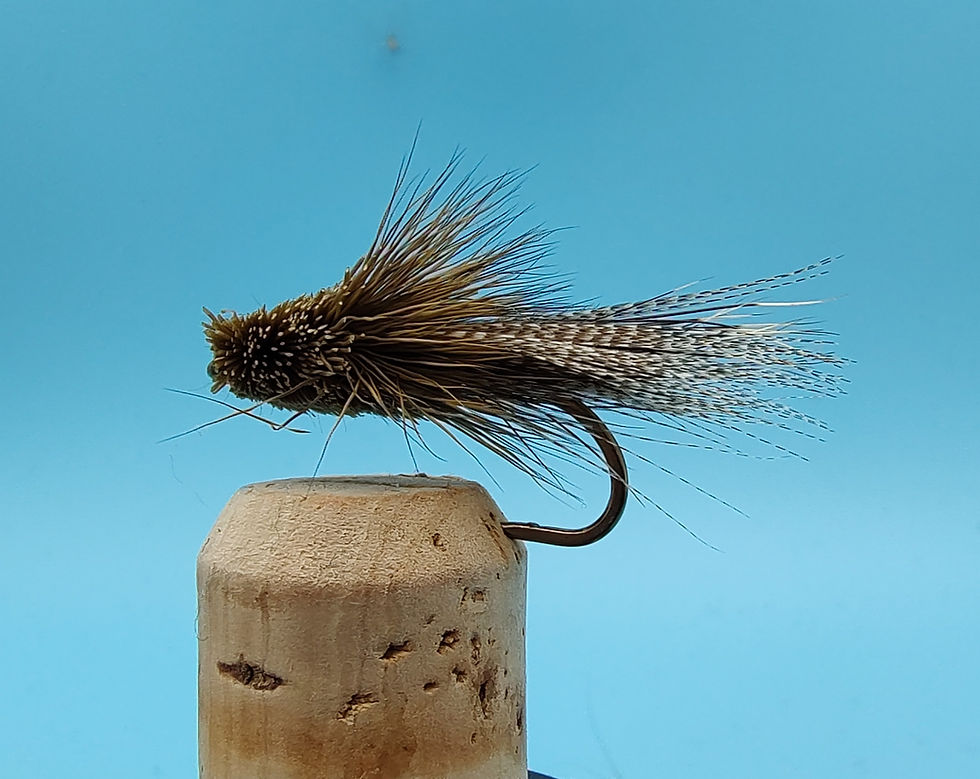Project Muddler: Woodchuck Muddler
- Jason G. Freund
- Apr 5, 2023
- 4 min read
There are TONS of variations on Don Gapen's original Muddler Minnow. The Woodchuck Muddler, as best as I know, is a Wolf River (Wisconsin) pattern (for other Wolf River Flies, visit the Flies of the Wolf River post). It is difficult to gather much information about this fly but it is one of the first few flies I learned to tie. It has long been a staple of the Wolf River. If it was not developed on the Wolf River, it certainly was - and still is - widely used there.

Woodchuck Muddler
Hook: 3 or 4 extra long shank
Thread: Your choice; 6/0 or 140 denier is a good choice
Tail: Woodduck flank fibers]
Body: Gold metal tinsel
Rib: Very fine gold wire and a bit of underfur
Wing: Woodchuck guard hairs
Collar: Deer hair (sparse)
Head: Deer hair
I have not found the pattern online or in a book, this is what I can gather from looking at Ed Haaga's version which I assume is rather the standard pattern. The only thing that I am unsure of is the rib which I *think* is a really fine wire. This fly is from, at the latest, the early 1980's and probably earlier than that. The metal tinsel and wire have tarnished and I am sure is quite duller and darker than it was at the time it was tied by Mr. Haaga.


To my eye, the Woodchuck Mudder is more darter-looking than sculpin-looking, which was the intent of the original Gapen Muddler Minnow. Although I do not think that fish are all that discerning when it comes to a large meal like a "minnow" (neither darters or sculpin are minnows). The Ed Haaga tie is certainly sparse. The sparseness and the small head, I assume, helps allow the fly to be fished relatively deeply more easily.

I do not know a whole lot about this fly and am hoping others will add information in the comments. As best as I know, it is a Wolf River fly and I have not heard of this variation elsewhere. I have no idea if it is an Ed Haaga creation or if it predates him. What I do know is that it works and has long been popular around the Wolf River. It is a fly I learned to tie over 30 years ago from George Close.

Woodchuck is not a terribly common tying material but a material that seems somewhat more commonly used in Wisconsin than elsewhere. The "Chuck Caddis" has long been a favorite fly of mine for brook trout and the Llama is a favorite small streamers. The Woodchuck Special is a rather fancier streamer fly pattern that is popular in New England.

In my opinion, Muddlers for fishing should be relatively quick to tie. Save the really dense, well shaped heads for showing off. Though a larger, more buoyant head can be advantageous when fished on a sinking leader, which is how I typically fish a Muddler (if I am not being lazy...).

As with any fly pattern, the fun is playing around with it and make it your own. Vary the hook; add weight; play around with the head shape, and body, wing, and tail materials. The fly above, I put a wood duck flank feather wing over the woodchuck and finished it with an olive head. It was my attempt at a better darter imitation.
The flies above are my attempts at a more faithful version of the Woodchuck Muddler. The heads are a single, small bunch of deer hair whereas the other flies I tied were two stacks of deer hair which makes for a larger, denser head.

The Ed Haaga version of the fly I have is very sparse with a simple head and rather few fibers that make up the collar. It took me a few attempts to tie flies as sparsely as I did - yet not as sparse as the Ed Haaga version I have on display. My instincts were to tie a much more full head and collar. I felt a bit like Norman Maclean in A River Runs Through It - again, half as much material...

This version strays rather far from the original fly pattern. My goal with this version is for a fly that I can fish on a sinking leader. The large head will create some buoyancy and push some water. I look forward to trying it out soon. This is a rather rounded head but for flies fished on sinking leaders, I often tie them a bit more like a small Zoo Cougar-style head to give them a little bit of inherent wobble.

The idea for the Badger Muddler came from the Woodchuck Muddler. It is a fly I tie more for show than anything. The body is red silk floss with a silver tinsel rib to give it the Badgers' colors. And obviously the wing is badger rather than woodchuck.
Give the Woodchuck Muddler a go. Tie it sparse and traditional or play around and make it your own.





Good woodchuck is a rare find in a fly shop. I found mine on the highway. I use it for the chuck caddis, the llama, and the woodchuck muddler.
I don't like to add wire weight to my flies,but the discussion of dense vs spare heads is a good one. I'll carry muddlers with a range of head sizes and densities to fish higher or lower in the water column. For the deepest flies I'll tie a spare head muddler on the hooks made for Atlantic salmon flies.
THE HORNBERG FLY FISHERS HANDBOOK pictured was editied by Donald Larmouth. Dr. Larmouth was my linguistics professor at UM Duluth in the spring of 1970. Soon after that he moved on to…